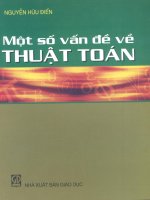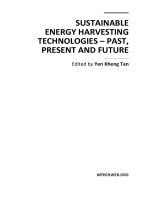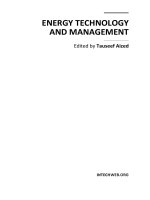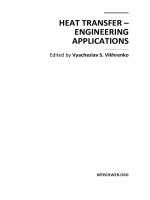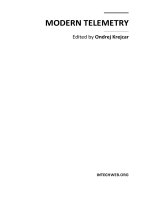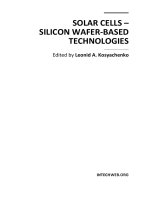New Tribological Ways Part 1 pot
Bạn đang xem bản rút gọn của tài liệu. Xem và tải ngay bản đầy đủ của tài liệu tại đây (2.41 MB, 35 trang )
NEW TRIBOLOGICAL WAYS
Edited by Taher Ghrib
New Tribological Ways
Edited by Taher Ghrib
Published by InTech
Janeza Trdine 9, 51000 Rijeka, Croatia
Copyright © 2011 InTech
All chapters are Open Access articles distributed under the Creative Commons
Non Commercial Share Alike Attribution 3.0 license, which permits to copy,
distribute, transmit, and adapt the work in any medium, so long as the original
work is properly cited. After this work has been published by InTech, authors
have the right to republish it, in whole or part, in any publication of which they
are the author, and to make other personal use of the work. Any republication,
referencing or personal use of the work must explicitly identify the original source.
Statements and opinions expressed in the chapters are these of the individual contributors
and not necessarily those of the editors or publisher. No responsibility is accepted
for the accuracy of information contained in the published articles. The publisher
assumes no responsibility for any damage or injury to persons or property arising out
of the use of any materials, instructions, methods or ideas contained in the book.
Publishing Process Manager Ivana Lorkovic
Technical Editor Teodora Smiljanic
Cover Designer Martina Sirotic
Image Copyright Christian Lagerek, 2010. Used under license from Shutterstock.com
First published March, 2011
Printed in India
A free online edition of this book is available at www.intechopen.com
Additional hard copies can be obtained from
New Tribological Ways, Edited by Taher Ghrib
p. cm.
ISBN 978-953-307-206-7
free online editions of InTech
Books and Journals can be found at
www.intechopen.com
Part 1
Chapter 1
Chapter 2
Chapter 3
Chapter 4
Chapter 5
Part 2
Chapter 6
Chapter 7
Chapter 8
Preface IX
Tribology of Thin Layers 1
Study of CrAlN Multilayred Thin Films 3
Tlili Ibrahim and Taher Ghrib
Optical Characterization of Elastohydrodynamic
Lubrication Pressure with Surface Plasmon Resonance 21
C.L. Wong, X. Yu, P. Shum and H.P. Ho
Tribological Properties of Fluorinated
Amorphous Carbon Thin Films 47
Miguel Rubio-Roy, Carles Corbella,
José-Luís Andújar, Enric Bertran
Deposition and Tribology of Carbon
and Boron Nitride Nanoperiod Multilayer
Hard and Solid Lubricating Films 71
Shojiro Miyake and Mei Wang
Ferrofluid Seals 89
V. Lemarquand and G. Lemarquand
Tribology in Cutting 115
Characteristics of Abrasive Particles
and Their Implications on Wear 117
Giuseppe Pintaude
Topographical Change of Engineering Surface
due to Running-in of Rolling Contacts 131
R. Ismail, M. Tauviqirrahman, Jamari and D.J. Schipper
Tribology in Water Jet Processes 153
Seiji Shimizu
Contents
Contents
VI
The Elliptical Elastic-Plastic Microcontact Analysis 165
Jung Ching Chung
Methods of Choosing High-Strengthened
and Wear-Resistant Steels on a Complex
of Mechanical Characteristics 197
Georgy Sorokin and Vladimir Malyshev
A Comparison of the Direct Compression Characteristics
of Andrographis paniculata, Eurycoma longifolia Jack, and
Orthosiphon stamineus Extracts for Tablet Development 219
Yus Aniza Yusof, Aziana Azlin Abdul Hamid,
So’bah Ahmad, Norawanis Abdul Razak,
Chin Nyuk Ling and Suhaila Mohamed
Tribology and Low Friction 233
Frictional Property of Flexible Element 235
Keiji Imado
Surface Friction Properties of Fabrics and Human Skin 265
Mari Inoue
Investigation of Road Surface Texture Wavelengths 273
Chengyi Huang and Shunqi Mei
Adhesion Theory for Low Friction on Ice 301
Katsutoshi Tusima
Tribology of 2-Mercaptobenzothiazole
in Lithium Complex Grease 329
B S Nagarkoti
Tribology and Lubrication 333
No Conventional Fluid Film Bearings
with Waved Surface 335
Florin Dimofte, Nicoleta M. Ene and Abdollah A. Afjeh
Identification of Discharge Coefficients
of Orifice-Type Restrictors for Aerostatic
Bearings and Application Examples 359
Guido Belforte, Terenziano Raparelli,
Andrea Trivella and Vladimir Viktorov
Inverse Approach for Calculating Temperature in Thermal
Elasto-Hydrodynamic Lubrication of Line Contacts 381
Li-Ming Chu, Hsiang-Chen Hsu, Jaw-Ren Lin and Yuh-Ping Chang
Chapter 9
Chapter 10
Chapter 11
Part 3
Chapter 12
Chapter 13
Chapter 14
Chapter 15
Chapter 16
Part 4
Chapter 17
Chapter 18
Chapter 19
Contents
VII
Construction of Various Self-assembled Films
and Their Application as Lubricant Coatings 403
Jinqing Wang, Junfei Ou, Sili Ren and Shengrong Yang
A Novel Tool for Mechanistic Investigation
of Boundary Lubrication: Stable Isotopic Tracers 425
Ichiro Minami
FEM Applied to Hydrodynamic Bearing Design 451
Fabrizio Stefani
Comparison between Different Supply Port
Configurations in Gas Journal Bearings 477
Federico Colombo, Terenziano Raparelli and Vladimir Viktorov
Chapter 20
Chapter 21
Chapter 22
Chapter 23
Pref ac e
The tribology term comes from the Greeks of the words ‘’ tribos’’ meaning ‘’ friction ‘’,
and ‘’logos’’ meaning ‘’ law ‘’. Therefore Tribology is defi ned as “ a science which stud-
ies surfaces moving one compared to the other “ and also a fi eld of science studying
lubrication, friction, and wear.
This book aims to recapitulate old informations available and brings new informations
that are with the fashion research on an atomic and nanometric scale in various fi elds
by introducing several mathematical models to measure some parameters character-
izing metals like the hydrodynamic elasticity coeffi cient, hardness, lubricant viscosity,
viscosity coeffi cient, tensile strength It uses measurement techniques very devel-
oped and nondestructive such as the optical and thermal methods like those used with
chapters I, II.
The principal distinction of this book is that it brings practical manners to model and
to optimize the cu ing process using various parameters and diff erent techniques,
namely, using water of high-velocity stream, tool with diff erent form and radius, the
cu ing temperature eff ect, that can be measured with suffi cient accuracy not only at a
research lab and also with a theoretical forecast.
Therefore this book aims to minimize and eliminate the losses resulting from surfaces
friction and wear which leads to a greater machining effi ciency and to a be er execu-
tion, fewer breakdowns and a signifi cant saving.
A great part is devoted to lubrication, of which the goal is to fi nd the famous techniques
using solid and liquid lubricant fi lms applied for giving super low friction coeffi cients
and improving the lubricant properties on surfaces.
To recapitulate the book contains twenty three chapters which can be arranged in four
sections entitled as follows:
• Tribology of Thin Layers
• Tribology in cu ing
• Tribology and low friction
• Tribology and Lubrication
The sessions which are quoted before and their contents are enumerated and devel-
oped below:
X
Preface
Part 1 Tribology of Thin Layers
CHAPTER 1 STUDY OF CRALN MULTILAYRED THIN FILMS.
This chapter stipulates that the characterizations microstructural, morphological and
physicochemical of a various multi-layer coatings deposited on surface are essential, of
which the objective is it to connect the mechanical properties of these deposits to their
macroscopic study like the forces of adhesion and microscopic like the pores surface
and the cells sizes by using methods of optic and thermal characterizations like the
AFM and the PTD technique.
CHAPTER 2 OPTICAL CHARACTERIZATION OF ELASTOHYDRODYNAMIC LUBRI-
CATION PRESSURE WITH SURFACE PLASMON RESONANCE
This chapter completes recent advances of optical techniques for Elastohydrodynamic
lubrication (EHL) studies and reports a recent application of surface plasmon reso-
nance (SPR) sensing for the imaging of EHL point contact. A nondestructive technique
based on the interference of two luminous rays, one collimated beam incidents and the
other refl ects on the sensing surface at the resonance angle (~65°). A er enlargement
the SPR image is further processed by an image analysis program for two dimensional
Hue profi le extraction and processing and using an experimental calibration curve,
the Hue profi le is further converted into corresponding refractive index distribution.
Finally, the map of SPR resonance minimum is converted to corresponding RI distribu-
tion with the help of a calibration curve it could noticed that only a small increase in
refractive index is found in the outermost region of the dimple, which corresponds to
the contact zone between the steel ball and the glass surface.
CHAPTER 3 TRIBOLOGICAL PROPERTIES OF FLUORINATED AMORPHOUS CAR-
BON THIN FILMS
In this chapter the atomic fl at layers on surface samples are manufactured with very sig-
nifi cant tribological properties and which are used for signifi cant applications such as
hard drive disk coating. Among the deposition it shows the importance of the technique
known in the literature as diamond-like carbon (DLC), which can only be obtained at
conditions far away from equilibrium, and so it is not spontaneously found in nature.
The control of the growth parameters broadens the fi eld of microstructures and, in par-
allel, the properties of this material, which can only be synthesized in thin fi lm form.
The fastest growing market for DLC simplify the manufacture of multilayers tribologi-
cal coatings, this coating it implanted with protective fi lms, which can reduce corrosion
and wear, may extend the lifetime of implants by preventing or alleviating the afore-
mentioned issues. The friction coeffi cient of the sample depends to the etching dura-
tion it varies from 13% for 15 min to 26% for 30 min this variation may be ascribed to the
trapping eff ect of the pits defi ned by the micro-pillars that appears on the surface.
CHAPTER 4 DEPOSITION AND TRIBOLOGY OF CARBON AND BORON NITRIDE
NANOPERIOD MULTILAYER HARD AND SOLID LUBRICATING FILMS
The aim of this chapter is focused on developing a new solid lubricant fi lm with an ex-
tremely low friction which usual simple fi lm and mixed fi lm material lacked of carbon
XI
Preface
and boron nitride nanoperiod multilayer (C/BN)n whish are deposited by RF spu er-
ing using two semicircular targets. Nanoindentation and microwear tests were carried
out to investigate the nanometer-scale deformation properties, macroscopic friction
coeffi cient and sliding endurance of these fi lms.
CHAPTER 5 FERROFLUID SEALS
This chapter intends to explain how ferrofl uid seals are formed in magnetic structures
by presenting a simple analytical model to describe their static behavior. The seal shape
and performances are described with regard to the magnetic structure. The evaluation
of the seal static capacity is given. Moreover, the seal shape changes when the seal is
radially crushed by the inner cylinder: these changes are described and calculated and
the radial force exerted by the ferrofl uid on the moving part is determined as well as
the stiff nesses associated. Then, various magnetic structures are presented and stud-
ied to illustrate the magnet role and deduct some design rules for ferrofl uid seals with
given mechanical characteristics.
Part 2 Tribology in Cu ing
CHAPTER 6 CHARACTERISTICS OF ABRASIVE PARTICLES AND THEIR IMPLICA-
TIONS ON WEAR
This chapter studies the characteristics aff ecting the wear rate caused by the abrasive
particles such as Geometry, hardness and size and their implications on wear. The
eff ect of abrasive particle size in wear on mass loss of mo led cast iron with diff erent
retained austenite contents was studied, a high increase of mass loss with abrasive size
can be observed, up to approximately 70 microns. A er this, a scheme shows how the
increase of particle size can mean a change only in the height roughness parameter
with no variation in the slope of surface. Specifi c energy for cu ing as a function of tool
radius, it is high for small particles.
An experimental study is undertaken to low-carbon steel and the measurement of its
mass losses and friction coeffi cients, it is possible to calculate the abrasion factor, f
ab
,
by using the relationship: f
ab
= K
A
/ μ
P
where K
A
is the wear coeffi cient and μ
P
is the
ploughing component of the friction coeffi cient and a er it make that possible to con-
clude that the λ
q
roughness which discriminating the eff ect of particle size under se-
vere wear, which shows that the abrasive characteristics are changed a li le during the
mechanical contact.
CHAPTER 7 TOPOGRAPHICAL CHANGE OF ENGINEERING SURFACE DUE TO
RUNNING-IN OF ROLLING CONTACTS.
This chapter studies analytically, experimentally and numerically the topographical
change due to running-in of rolling contact. A running-in model of rolling contact by
considering the deterministic contact of the engineering surface has been proposed
which performs a good agreement with the experiments. Finite element simulations of
two-dimensional rolling contact model contribute in illustrating the truncation of the
highest asperity, the contacted stress and the residual stress due to plastic deformation.
XII
Preface
The comparison of the repeated static contact and the repeated rolling contact leads
un-similarity in material transfer direction and asperity deformation. This investiga-
tion can contribute in predicting the initial, the change, and the fi nal of the surface to-
pography for a success running-in stage. Running-in plays an important role in plastic
deformation, friction and wear of tribology systems during the steady-state period.
CHAPTER 8 TRIBOLOGY IN WATER JET PROCESSES
This chapter describes the history of water je ing technology, high-pressure pumps
and water jet machining systems, various water jets used in water jet processes, and
material removal mechanisms of water jets. Several points infl uencing the effi ciency,
reliability, and lifetime of the high-pressure pump such as Friction and wear between
the cylinder and the piston were studied; and also it shows that the corrosion and
erosion in valves and nozzles are serious problems that aff ect the reliability of water
je ing systems.
CHAPTER 9 THE ELLIPTICAL ELASTIC-PLASTIC MICROCONTACT ANALYSIS.
This work accounted the relationship between the geometry and material to study
the behavior of an ellipsoid deformable coming into contact with a rigid apartment
elastoplastic. The material is modeled with elliptic symmetry and analyzed with the
fi nished analysis of element (FEA). In order to validate the model, the mesh density is
iteratively increased until the contact force and contact area diff ered by less than 1% be-
tween iterations. In the fi nite element analyses, the resulting meshes consist in framing
elements corresponding to ellipticity by varying the radii of curvature at the ellipsoid
tip used the contact deformation.
CHAPTER 10 METHODS OF CHOOSING HIGH-STRENGTHENED AND WEAR-RE-
SISTANT STEELS ON A COMPLEX OF MECHANICAL CHARACTERISTICS
This chapter presents the methods which make it possible to choose a steel of high
strength and resistant to wear while exploiting a complex of the mechanical character-
istics. The analysis results of an extensive experimental data show that for providing
the best indexes of wear resistance at mechanical outwearing it is necessary to combine
three components: high static toughness, hardness and plasticity. Only the combina-
tion of such characteristics provides the best results regarding the wear resistance in-
crease. This task in defi ned aspects is fi nished up to an engineering decision and can
be used in designer’s practice for choosing the wear-resistant steels and alloys. The
tendered methods allow not only to produce an estimation of suitable steels for
diff erent conditions of wear and external forces of uploading, but also to ori-
ent metallurgists to melting new steels with quite defi ned mechanical properties and
their combinations.
CHAPTER 11 A COMPARISON OF THE DIRECT COMPRESSION CHARACTERIS-
TICS OF ANDROGRAPHIS PANICULATA, EURYCOMA LONGIFOLIA JACK, AND
ORTHOSIPHON STAMINEUS EXTRACTS FOR TABLET DEVELOPMENT.
This chapter presents a comparison of the direct characteristics of compression in-
troduced by Andrographis paniculata, Eurycoma longifolia Jack, and Orthosiphon
XIII
Preface
stamineus and which is checked on selected powders of grass extract of Malaysie and
discuss the properties of such powders. The compressions were performed at room
temperature between 23 °C and 26 °C with the humidity between 37 and 42% RH. The
comparison of the effi cacity of the various techniques amounts comparing the proper-
ties tribological such as tensile strength, grain size of tablets manufactured. IT proves
that Eurycoma longifolia Jack extract powder was the easiest of the three herb powders
to compress, and it underwent signifi cant particle rearrangement at low compression
pressures, resulting in low values of yield pressure.
Part 3 Tribology and Low Friction
CHAPTER 12 FRICTIONAL PROPERTY OF FLEXIBLE ELEMENT.
The chapter presents the theory of belt buckle by considering the self-locking mecha-
nism generated by wrapping the belt on belt friction, presents the frictional property
of belt wrapped on an axis two and three times through deriving the formulas corre-
sponding to an each condition and fi nally discus frictional property of fl exible element
wrapped on a hard body with any contour. The frictional force can be calculated by
the curvilinear integral of the curvature with respect to line element along the contact
curve. Utilizing the self-locking property of belt, a novel one-way clutch was devel-
oped. The problem of this clutch is how to get the smaller and stable coeffi cient of belt-
belt friction for long time use.
CHAPTER 13 SURFACE FRICTION PROPERTIES OF HUMAN SKIN AND THE FRIC-
TION BETWEEN FABRICS AND SKIN.
This chapter studies the properties external of friction of the skin and materials of
clothing, using twelve fabrics consists of various fi ber, yarn structure, and the yarn
density. The experimental apparatus measuring the surface friction properties and the
measuring results of fabrics are explained and the Friction between human skin and
fabrics are measured. The eff ects of the friction of fabrics and the moisture regain of
human skin are shown.
CHAPTER 14 INVESTIGATION OF ROAD SURFACE TEXTURE WAVELENGTHS.
In this paper, experimental texture measurements and Data Dependent Systems (DDS)
modeling methodology were introduced to analyze the real road pavement surfaces.
The elevation profi les collected from real road core surfaces were composed of 1 mi-
cron step size scan and 45 micron step size scan by an accurate laser sensor and were
modeled by DDS program and it mentioned that a er more factors that aff ect the sur-
face roughness are considered, a be er correlation of roughness with friction can be
obtained.
CHAPTER 15 ADHESION THEORY FOR LOW FRICTION ON ICE
This chapter proposes a study of the frictions on the surface of the ice and it seeks the
various causes which are responsible for its low values, it concludes that the increase
in the friction is caused by the ploughing of ice at the contact area and it noticed that
XIV
Preface
the minimum friction is shi ed because the higher temperature generated following
the reduction of the heat propagation velocity and with the water vapor pressure on
the surface.
CHAPTER 16 TRIBOLOGY OF 2-MERCAPTOBENZOTHIAZOLE IN LITHIUM COM-
PLEX GREASE
This chapter proposes a study of the properties of 2-Mercaptobenzothiazole and the ef-
fect of its addition on a complex grease of lithium. The developed complex grease was
tested for other regular characteristics in addition to tribological properties. It summa-
rized that 2- Mercaptobenzothiazole has exceptional load carrying capacity compared
to conventional EP additives and the grease show very low coeffi cient of friction and
good additive response.
Part 4 Tribology and Lubrication
CHAPTER 17 NO CONVENTIONAL FLUID FILM BEARINGS WITH WAVED
SURFACE
In this chapter, the wave bearings lubricated with incompressible fl uids, commonly
known as fl uid fi lm wave bearings, are analysed. The performance of both journal
and thrust bearings is examined and it examines that one of most important proper-
ties of the wave journal bearings compared to other types of journal bearings is their
improved stability. The wave thrust bearings can be used for axially positioning the
rotor or to carry a thrust load. For this reason, the fi rst part of the chapter is devoted
to the study of the dynamic behaviour of the journal wave bearingsand the second
part executes the steady state of the thrust wave bearings. It stipulates that wave jour-
nal bearing steady-state and dynamic performance can be precisely predicted with
computer codes validated by experiments on dedicated test rigs and the wave ampli-
tude, the minimum fi lm thickness, oil supply pressure and temperature, as well as the
number of waves can be used to maximize the bearing performance for a particular
application.
CHAPTER 18 IDENTIFICATION OF DISCHARGE COEFFICIENTS OF ORIFICE-TYPE
RESTRICTORS FOR AEROSTATIC BEARINGS AND APPLICATION EXAMPLES
The chapter describes an experimental study conducted in order to identify the supply
hole discharge coeffi cients of externally pressurized gas bearings. Tests were carried
out over specifi c hole, feed pocket and air gap size ranges on pneumatic pads with two
types of air feeding systems: annular orifi ces and simple orifi ces with feed pocket. For
simple orifi ces with feed pocket, the fl ow characteristics can be described using two
experimental discharge coeffi cients: C
d,c
for the circular section of the orifi ce and C
d,a
for
the annular section of the air gap in correspondence of the pocket diameter.
Air consumption and pressure distributions were measured as a function of supply
pressure and air gap height. Discharge coeffi cients were approximated by an experi-
mental formula based on the Reynolds number and the feeding system geometry.
The validity of the formulation found in the study was verifi ed by comparing the
XV
Preface
numerically calculated pressure distribution with the experimental distribution mea-
sured on diff erent pad types.
CHAPTER 19 INVERSE APPROACH FOR CALCULATING TEMPERATURE IN THER-
MAL ELASTO HYDRODYNAMIC LUBRICATION OF LINE CONTACTS
This research proposes a thermal elastohydrodynamic lubrication (TEHL) inverse ap-
proach to estimate the pressure, temperature rise, and apparent viscosity distributions
in an EHL line contact, it requires a lot of measured points of fi lm thickness to establish
the amplitude and location of the pressure and temperature spikes where the pressure
and estimated fi lm thickness distributions can be calculated from force balance and
elastic deformation theories.
CHAPTER 20 CONSTRUCTION OF VARIOUS SELF ASSEMBLED FILMS AND THEIR
APPLICATION AS LUBRICANT COATINGS
In this chapter, the tribological behaviors of self-assembled nanofi lms (SANFs), in-
cluding self-assembled monolayers (SAMs), self-assembled multilayer fi lms (SAMFs),
self-assembled inorganic fi lms (SAIFs) and self-assembled organic-inorganic compos-
ite fi lms (SAO-ICFs), are reviewed, aiming at discovering the basic “microstructures-
properties” correlation. It is expected that the extracted “structures-properties” corre-
lation can serve as the guidance to direct the further designing of lubricant coatings for
MEMS/NEMS and other devices in molecule-level. Theses fi lms these fi lms can gener-
ated a great importance not only for its simple preparation procedure but also for its
wide potential applications in many fi elds, such as surface modifi cation, boundary lu-
bricant coatings, sensors, photoelectronics, and functional bio-membrane modelling.
CHAPTER 21 A NOVEL TOOL FOR MECHANISTIC INVESTIGATION OF BOUND-
ARY LUBRICATION: STABLE ISOTOPIC TRACERS
This chapter proposes a new tool for mechanistic investigation in tribo-chemistry. The
main subject of this investigation is based on the secondary ion mass spectroscopy
study (SIMS) of surfaces rubbed with isotope-labeled lubricants. It begins by explain-
ing the technique of SIMS and its advantage analysis for tribo-chemistry, followed by
the tribological properties and lubrication mechanism of monomolecular fi lms with
friction modifi ers, the tribo-chemical reaction of diamond-like carbon with water and
fi nished by an analysis of the boundary fi lm yielded from additives in lubricants.
CHAPTER 22 FEM APPLIED TO HYDRODYNAMIC BEARING DESIGN.
The present chapter is aimed to provide the theoretical foundation of Finite-Element
Method (FEM), mass- and energy-conserving models as well as to report their applica-
tion to the ThermoHydroDynamic (THD) and ThermoElastoHydroDynamic (TEHD)
analysis of diff erent bearing types. The application examples are relevant to both jour-
nal and axial bearings with fi xed and tilting pads, in order to demonstrate the high
fl exibility of the method. The most used FEM formulations of the mass-conserving
lubrication problem have been proved, while an original approach to the thermal
problem has been explained. Whereas, TEHD models are very sensitive to boundary
XVI
Preface
conditions, its choice is particularly diffi cult in all of the multi-physics simulations.
The scope of the chapter is anyway limited to the analysis of steadily-loaded bearings
working in laminar lubrication regime.
CHAPTER 23 COMPARISON BETWEEN DIFFERENT SUPPLY PORT CONFIGURA-
TIONS IN GAS JOURNAL BEARINGS.
The aim of this chapter is to compare three externally pressurized gas journal bearings
at given air consumption rates. The idea was to investigate which off ers the best spatial
distribution of supply orifi ces under the same pneumatic power. The study compared
radial stiff ness and pressure distribution for the three bearing types, also evaluating
the damping factor and the whirl ratio of the sha . The stability threshold was calcu-
lated for diff erent restriction parameters so that the proposed bearing types could be
compared.
Taher Ghrib
Part 1
Tribology of Thin Layers
1
Study of CrAlN Multilayred Thin Films
Tlili Ibrahim
1
and Taher Ghrib
2
1
Laboratoire Bourguignon des Matériaux et Procédés (LaboMap),
CER ENSAM de Cluny 71250
2
Technopole Borj Cedria
1
France
2
Tunisia
1. Introduction
The optimization of mechanical and tribological properties of monolayer coatings
developed and studied is a way of reaching and important research, because of their
potential application in various mechanical fields. Hardness and tenacity are the first two
principal characteristics of the deposits which it is necessary to optimize them to improve
their wear resistance. From this, the layers Cr, CrN and CrAlN are superimposed with
different levels of constraints residual (Pc, Pt or combined) to obtain multilayer coatings that
fulfill better the industrial requirements.
The characterizations microstructural, morphological and physicochemical of the various
multi-layer coatings are essential within the framework of this study, of which the objective
is it to connect the mechanical properties of these deposits to their macroscopic and
microscopic study.
A variety of multilayer systems such as TiN/CrN [1], TiAlN/CrN [2], TiN/TiAlN [3], etc.,
have been studied extensively. However, there are very few reports on the multilayer
coatings based on CrN and CrAlN [4]. The addition of Al to CrN system permits to work at
higher temperatures where the oxidation occurs [5]. CrAlN coatings have been reported to
be stable up to a temperature of 900°C depending upon the Al content in the coatings [6].
CrAlN coatings also exhibit higher hardness and a lower friction coefficient compared to
CrN coatings [7]. The new ternary film structure brought about significant advances in
coating designs, such as the decrease of the grain size and the formation of grain boundaries
between the two phases. As a consequence, it is reported that CrAlN films exhibited
excellent mechanical properties and oxidation resistance owing to their solid solution
structure [8]. Furthermore, it is well known that most properties of these solid solution
composite films are influenced by certain factors such as crystalline structure and micro-
structure. These factors led to the study of the multilayers coatings of CrN/CrAlN and
Cr/CrN/CrAlN, in which the properties of Cr, CrN and CrAlN can be combined. The Cr
underlayer is considered as a bonding layer.
In this work, we have investigated the effect of thickness on residual stress and hardness of
the monolayers. Moreover, the relationship between mechanical properties and the stress
state of the multilayers coatings was also discussed and established.
New Tribological Ways
4
2. Structural, microstructural and morphological characterization
By taking account of the optimal conditions obtained on the mono-layers, we developed six
multi-layers coatings Cr/CrN/CrAlN and CrN/CrAlN with various residual stresses levels
in mono-layers which constituents them.
The films composition, thickness and roughness are given respectively by the EDS or WDS
analysis and the 3d optical profilmeter. (fig. 1).
The analysis carried out on the multi-layer coatings Cr/CrN/CrAlN or CrN/CrAlN shows
the homogeneity of various chemical compositions at the several surface points, the
principal characterizations results carried out are given in table 1.
According to analyses EDS one found that in the studied coatings the N/Cr report/ratio is
about 1.17 to 1.2 and that they contain only 2.2% atomic of oxygen to the maximum. The
roughness of films is characterized by two parameters (Ra and Rt) whose measured values
are high, which leads us to await a dispersion of hardness by tests of nano indentation.
Concerning the analysis by DRX (fig. 2), one will limit the study on the films PVD
1
and
PVD
4
since the total thickness of other films is low (< 35nm).
These multi-layers is elaborate with low internal stresses (Pt). The coating PVD
4
is presented
by the peaks of principal diffraction [ (111) and (200) respectively with 36.8° and 51.27°, to
compare with file PDF 76-2494, PCPDFWIN version 2.3, JCPDS-ICDD (2002) ] [9]. The
addition of an under-layer Cr to the coating PVD
4
one obtains the film PVD
1
and this gives a
peak to position 2θ = 43.6° allotted to the presence of a cubic phase CrN (111) identical to the
ref [9-11].
In addition, it is established that the peaks Cr
2
NR (111) and CrN (200) are confused they is
because of the effect of under-stoechiometric coatings. Another remark, one can conclude
according to the spectra obtained on the multi-layers PVD
1
and PVD
4
that the CrN layer
crystallizes on the surface according to the preferential orientation (311) whereas it
crystallizes in volume according to the preferential orientation (200) [12]. The quantitative
Fig. 1. Topography of coating PVD
1
obtained by the optical profilometer.
Study of CrAlN Multilayred Thin Films
5
Rugosité ( µm)
Revêtements
N
(at. %)
Al
(at. %)
Cr
(at. %)
N/Cr
Total
thickness
(nm)
Rugosité
arrithmétique
(R
a
)
Quadratic
roughness
(R
q
)
Cr/CrN/CrAlN
(P
t
/P
t
/P
t
):PVD
1
51.8 4.2 42.9 1,2 1500 0.1 0.14
CrN/CrAlN
(P
t
/P
c
):PVD
2
50.8 4 43.1 1.17 300 0.12 0.16
Cr/CrN/CrAlN
(P
t
/P
c
/P
c
):PD
3
50.5 4.7 42.5 1.18 300 0.11 0.15
CrN/CrAlN
(P
t
/P
t
):PVD
4
52 5 41.3 1.2 1500 0.13 0.15
CrN/CrAlN
(P
c
/P
c
):PVD
5
49.7 4.9 43.6 1.18 256 0.12 0.16
Cr/CrN/CrAlN
(P
c
/P
c
/P
c
):PVD
6
50.1 4.2 44.5 1.17 356 0.09 0.13
Table 1. Chemical composition and topography
40 50 60 70 80 90
0
100
200
300
400
500
600
700
Cr
2
N( 111)
Substrat
Cr( 220)
CrN( 200)
CrN ( 111)
CrN( 311) h-AlN
CrN( 111) h- AlN
Intensité
2θ(degree)
PVD1: (Cr/CrN/CrAlN)Pt
PVD4: (CrN/CrAlN)Pt
AISI4140
Fig. 2. Diffraction spectra of x-rays obtained with the multi-layer PVD1, PVD4 and steel
42CrMo4.
analysis of the layer revealed the coexistence of the CrN phases and Cr2N, this result is
confirmed by C Nouveau [13, 14]. An observation in HRTEM and diffraction stereotype
confirmed the presence of a mixture of CrN (200) phases in the Cr2N layer.
We remark that by adding a Cr underlayer to the PVD
4
coating, the peak CrN (111)
disappeared completely.
This can be explained by the fact why the plans (311) have a speed of growth more
significant than the plans (111) and by preferential pulverization of the atoms of nitrogen of
the plans (111) compared with those of the plans (311).
New Tribological Ways
6
In addition, the presence of a crystallographic structure is related to the column-like
morphology of the mono-layers Cr, CrN and CrAlN observed by SEM on a cross section
after a polishing mirror (fig. 3).
The growth of the structure in columns took place perpendicular to surface. The found
results are comparable with that obtained in work of Harish C. Barshilia and M. Okumiya,
M. Griepentrog [ 15, 16 ] carried out on the CrN/CrAlN layers.
In order to conclude this study from obtaining the multi-layers, have determined the
profiles of the chemical compositions versus the pulverization time (fig. 4). The interface
Fig. 3. SEM of a transverse cut followed by a polishing mirror coating Cr/CrN/CrAlN.
020406080100
0
20
40
60
80
100
2520 s
1500 s
600 s
Intensité (a.u.)
Temps de pulvérisation (min)
N1s
O1s
Al2p
Si2p
Cr2p
Fig. 4. Compositions Profiles of the Cr/CrN/CrAlN layer obtained by XPS.
Study of CrAlN Multilayred Thin Films
7
between the individual layers is not very clear, which proves that these layers are very
miscible. Moreover, there is a contamination of surface of this coating is highlighted by the
presence of species oxidized of chromium on a depth of a few tens of nanometers.
Aluminium is presented by a small proportion in the surface of CrAlN layer with 5% which
imply that it is not possible to distinguish the variation from its profile in the film.
By taking account dimensions of the aluminium atoms and its kinetic energy. It is well doped
in the CrN layer, which to allow him to reach a significant depth, from where the interface
between the two layers CrN/CrAlN is not remarkable. The profile of the flexible layer (Cr) is
more intense close to the interface layer/substrat which is coherent with the superposition of
muti-layers (Cr/CrN/CrAlN) on silicon. The interface is relatively narrow and the involved
species do not seem to penetrate in the substrate what attests the layer good quality.
One selected two moments over the pulverization time (600s and 1500s), of which the goal
to know the evolution of the specific spectrum of the studied multi-layer Cr/CrN/CrAlN.
The Fig. 5 (1) schows that spectra N
1s
of the studied layer revealed the presence of a
characteristic peak of chromium nitride centered at 397 eV. This result is found in the
references [17 - 18]. The width with middle height (WHM) for the two moments 600s and
1500s is about 1.45 eV and 1.62 eV respectively.
392 394 396 398 400 402 404
1)
N
1s
397 eV
Intensity (a.u.)
Binding energy (eV))
600s
1500s
Fig. 5.1.
The binding energy corresponds to the peak O
1s
is 531.5 eV, and the width with middle
height is about 2 eV (fig. 5 (2)) for the two moments.
The peak associated to Cr (fig. 5(3)) is composed of two peaks centered at 574,8 and 584 eV,
who correspond to Cr
2P3/2
and Cr
2P1/2
respectively.
The widths with middle height (FWHM) for the two peaks are measured in the two selected
moments, 600 and 1500 and the values obtained are as follows: the peak Cr
2P3/2
(1.3 and 2.3)
and the peak Cr
2P1/2
(2.25 and 2.75), respectively.
The spectra Al
2p
and Cr
3s
(fig. 5(4)) are confused and the corresponding binding energy is
74.3 eV [ 15, 18 - 20 ]. The width with middle height is 3.75eVand 4.2eV for 600s and 1500s
respectively.
Investigations XPS on the figure I.1f, shows the presence of the elements O, N, Al and Cr in
the Cr/CrN/CrAlN coating. From the intensity of the peaks N
1s
, O
1s
, Cr
2p
and Al
2p
+ Cr
3s
,

